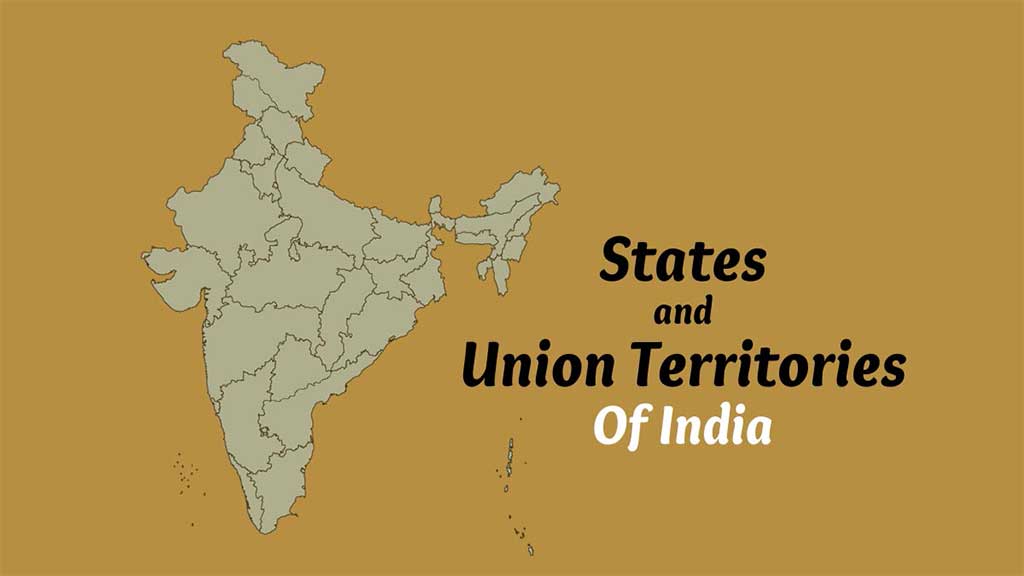States and Union Territories of India: After independence, many States and Union Territories come into existence immediately and rest in later years. At the type of independence, there were two types of political units, one is British provinces and the other is princely states.
As of November 1, 1956 there were 14 States and 6 Union Territories in India. But, presently there are 28 States and 8 Union Territories in India.

From exam point of view this is a very important topic and many questions are asked from this section. Here we are going to discuss about different States and Union territories of India.
Also Read: Neighbouring Countries of India
States and Union Territories in India
1. Andhra Pradesh
- Capital: Hyderabad
- Area: 2,75,069 sq. km (8th in India)
- Languages: Telugu and Urdu
- Year of Formation: 1st November, 1956
- State Animal: Black buck
- State Bird: Indian Roller
- State Tree: Neem
- Attached States: Maharashtra, Chhattisgarh, Odisha in the north side, the Bay of Bengal in the east side Tamil Nadu is in the south and Karnataka to the west.
After Gujarat Andhra Pradesh has the second longest coastline of 914 km. The major port of the state is Vishakhapatnam. Largest information technology of India is in the Hyderabad. It is known as the Rice Bowl of India and egg bowl of Asia. Hussein Sagar connects the twin city Hyderabad and Secunderabad. Golconda is famous for diamond mine.
2. Arunachal Pradesh
- Capital: Itanagar
- Area: 83,743 sq. km
- Language: Tribal Dialect
- Year of Formation: 20th February, 1987
- State Bird: Great Hornbill
- State Animal: Mithun
- State Flower: Fox tail Orchid
- State Tree: Hollong
- Attached States: Assam and Nagaland to the south.
Arunachal means “land of the dawn-lit mountains ” and also known as “land of the rising sun ” as this is the easternmost state of India. It also shares international boundaries with Bhutan, Myanmar and China.
The occupation of the people of Arunachal Pradesh is agriculture and shifting cultivation i.e. Jhum is practiced here. Rajiv Gandhi is the only university of the state.
3. Assam
- Capital: Dispur
- Area: 78,438 squad Km (17th in India)
- Year of Formation: 26th January, 1950
- Language: Assamese
- State Animal: Indian One-horned Rhino
- State Flower: Fox tail Orchid
- State Bird: White-wing wood duck
- State Tree: Hollong
- Attached States: Nagaland, Meghalaya, Arunachal Pradesh, Manipur, Tripura, Mizoram and West Bengal.
About 15% of the world’s tea production come from Assam. It is connected with the rest of the India through Siliguri corridor or chicken’s neck situated in West Bengal.
4. Bihar
- Capital: Patna
- Area: 94,163 sq. km
- Year of Formation: 26th January, 1950
- Language: Hindi
- State Animal: Gaur
- State Flower: Marigold
- State Bird: Sparrow
- State Tree: Peepal
- Attached States: Jharkhand, Uttar Pradesh, West Bengal
Bihar is also attached with Nepal. After the formation of Jharkhand most of the mineral-belt has gone to Jharkhand. Bodh Gaya, a town where Gautam Buddha attain enlightenment, located in the district of Gaya in Bihar. The 24th Tirthankara of Jainism, Vardhamana Mahavira was born in Vaishali.
5. Chhattisgarh
- Capital: Raipur
- Area: 1,35,192 sq. km
- Year of Formation: 1st November, 2000
- Language: Hindi
- State Animal: Wild Buffalo
- State Bird: Hill Myna
- State Tree: Sal
- Attached States: Madhya Pradesh, Odisha, Telangana, Andhra Pradesh, Maharashtra, Uttar Pradesh and Jharkhand.
Most of the people are depends on agriculture. It has mineral rich areas. It is a very important area for the production of electric power and steel. Chhattisgarh is famous for Kosa Silk and lost wax art.
6. Goa
- Capital: Panaji
- Area: 3,702 sq. km
- Year of Formation: 30th May, 1987
- Language: Konkani & Marathi
- State Animal: Gaur
- State Bird: Ruby Throated Yellow Bulbul
- State Tree: Matti
- Attached States: Karnataka, Maharashtra.
Goa is the smallest state of India by area. Marmagao is the major port of Goa. The largest city of Goa is Vasco Da Gama. Goa is a part of western ghats and is classified as a biodiversity hotspot.
7. Gujarat
- Capital: Gandhinagar
- Area: 1,96,244 sq. km
- Year of Formation: 1st May 1960
- Language: Gujarati
- State Animal: Asiatic Lion
- State Bird: Great Flamingo
- Attached States: Rajasthan, Maharashtra, Daman and Diu, Dadra and Nagar Haveli.
Gujarat is also share its border with Pakistan. It has the longest coastline in India of about 1600 km. Major producer of groundnut and cotton is Gujarat. Kandla port lies in Gujarat.
8. Haryana
- Capital: Chandigarh
- Area: 44,212 sq. km
- Year of Formation: 1st November, 1966
- Language: Hindi
- State Animal: Black Buck Antelope
- State Flower: Lotus
- State Bird: Black Francolin
- State Tree: Peepal
- Attached States: Punjab, Himachal Pradesh, Uttarakhand, Uttar Pradesh, Delhi, Rajasthan, Chandigarh (UT).
For the production of handloom Panipath is called the ‘Weaver City’. Asia’s largest timber industry, is in Yamuna Nagar.
9. Himachal Pradesh
- Capital: Shimla
- Area: 55,673 sq. km
- Year of Formation: 15th April, 1948 as Union Territory and on 25th January, 1971 as State
- Language: Hindi and Pahari
- State Animal: Snow Leopard
- State Flower: Pink Rhododendron
- State Bird: Western Tragopan
- State Tree: Deodar
- Attached States: Jammu and Kashmir, Punjab, Haryana, Uttarakhand.
Himachal Pradesh is also attached with China. There are mainly five major groups among their population viz. Gaddis, Kinners, Gujjars, Pangawals and Lahaulis. This is a hilly area and many hill station is constructed which attracted tourists. Horticulture and cash crops can be cultivated as it has optimum condition for these. Production of apple is prevalent here.
10. Jharkhand
- Capital: Ranchi
- Area: 79,716 sq. km
- Year of Formation: 15th November, 2000
- Language: Hindi
- State Animal: Elephant
- State Flower: Palash
- State Bird: Koel
- State Tree: Sal
- Attached States: Bihar, Uttar Pradesh, Chhattisgarh, Odisha and West Bengal.
The meaning of Jharkhand is ‘The Land of Forest’. Jharkhand is mineral-belt area and 37% of the country’s coal deposit is reserved here. Mineral such as copper 40%, iron 22%, mica 90% is deposited in this region. For this reason, Jharkhand is also known as ‘Storehouse of minerals’. Many steel companies are constructed here.
11. Karnataka
- Capital: Bengaluru
- Area: 1,91,791 sq. km
- Year of Formation: 1st November, 1956 as Mysore state and renamed in 1973.
- Language: Kannada
- State Animal: Elephant
- State Flower: Lotus
- State Bird: Indian Roller
- State Tree: Sandal Wood
- Attached States: Kerala, Goa, Maharashtra, Telangana, Andhra Pradesh and Tamil Nadu.
Karnataka is famous for sandal soap and sandal wood oil. Mangalore is the major port of Karnataka. Many research centres such as ISRO, BEL, Central Food Technological Research institute are situated here. Capital Bengaluru is famous for IT industries.
12. Kerala
- Capital: Thiruvananthapuram
- Area: 38,852 sq. km
- Year of Formation: 1st November, 1956
- Language: Malayalam
- State Animal: Elephant
- State Flower: Kanikonna
- State Bird: Great Hornbill
- State Tree: Coconut
- Attached States: Tamil Nadu, Karnataka, and Lakshadweep.
Kerala is famous for cash crop specially for species. It has highest literacy rate as well as highest sex ratio. The major port of Kerala are Calicut and Cochin.
13. Madhya Pradesh
- Capital: Bhopal
- Area: 3,08,252 sq. km
- Year of Formation: 1st November, 1956
- Language: Hindi
- State Animal: Swamp Deer
- State Bird: Paradise Fly Catcher
- Attached States: Maharashtra, Gujarat, Rajasthan, Uttar Pradesh and Chhattisgarh.
As it is in the center of the, also called ‘the heart of India’. This state is primarily dependent on agriculture. Initially it was the largest state of India but after the separation of Chhattisgarh it becomes in the second position. Approximately 18 biosphere reserves are situated here and out of these are Pachmari Biosphere Reserve and Amarkantak Biosphere Reserve.
14. Maharashtra
- Capital: Mumbai
- Area: 3,07,713 squad km
- Year of Formation: 1st May, 1960
- Language: Marathi
- State Animal: Giant Squirrel
- State Flower: Jarul
- State Bird: Green Imperial Pigeon
- State Tree: Mango
- Attached States: Gujarat, Madhya Pradesh, Telangana, Andhra Pradesh, Karnataka, Goa, Dadra and Nagar Haveli and Chhattisgarh.
Mumbai in Maharashtra is known as the economic capital of India. World’s famous film industry is located in Mumbai. It is the industrial powerhouse of India. The major ports are Mumbai and Jawaharlal Nehru Port.
15. Manipur
- Capital: Imphal
- Area: 22,327 sq. km
- Year of Formation: 21st January, 1972
- Language: Manipuri
- State Animal: Sangai
- State Flower: Siroy Lilly
- State Bird: Nongyeen
- State Tree: Uningthou
- Attached States: Mizoram, Assam and Nagaland.
Manipur is also attached to Myanmar. Biodiversity of Manipur very rich having various rare plants, trees and wildlife. The main profession of the people of Manipur is agriculture and also major source of economy.
16. Meghalaya
- Capital: Shillong
- Area: 22,429 sq. km
- Year of Formation: 2nd April, 1970
- Language: Garo, Khasi & English
- State Animal: Clouded Leopard
- State Flower: Lady Slipper Orchid
- State Bird: Hill Myna
- State Tree: Gamari
- Attached States: Assam
Meghalaya is attached with Bangladesh border. Agriculture is the main profession of the people of Meghalaya. World’s wettest place Mawsynram (in Cherapunji district) is in Meghalaya. Most of the area is covered by Forest.
17. Mizoram
- Capital: Aizwal
- Area: 21,081 sq. km
- Year of Formation: 20th February, 1987
- Language: Mizo and English
- State Animal: Serow (Saza)
- State Flower: Dancing girl (Aiting)
- State Bird: Hume’s Bar tailed Pheasant
- State Tree: Mesual Ferrea
- Attached States: Tripura, Assam and Manipur.
It shares its border with neighboring country Myanmar. It is one of the seven sister states. Agriculture is the major source of income. Jhum or shifting cultivation is prevalent here. The Blue Mountain, Phawngui Tlang is situated here.
18. Nagaland
- Capital: Kohima
- Area: 16,579 sq. km
- Year of Formation: 1st December, 1963
- Language: Chang, Konyak, Lotha, Sangtam, Sema and Chakhesang.
- State Animal: Mithuen,
- State Flower: Rhododendron
- State Bird: Blyth’s Tragopan
- State Tree: Alder
- Attached States: Manipur, Arunachal Pradesh and Assam.
Neighbouring country of Nagaland is Myanmar. Approximately 90% of the population is involved in agriculture. Nagaland is rich in flora and fauna.
19. Odisha
- Capital: Bhubaneshwar
- Area: 1,55,707 sq. km
- Year of Formation: 15th August, 1947
- Language: Oriya
- State Animal: Sambar
- State Flower: Asoka
- State Bird: Blue Jay
- State Tree: Aswattha
- Attached States: Andhra Pradesh, Chhattisgarh, Jharkhand and West Bengal.
Hirakud, world’s longest dam on the Mahanadi river is situated in Odisha. Famous brackish water lagoon Chilka lake which is India’s largest coastal lake is located in this state. It is an agricultural based economy and rice is the main crop.
20. Punjab
- Capital: Chandigarh
- Area: 50,362 sq. km
- Year of Formation: 1st November, 1966
- Language: Punjabi
- State Animal: Blackbuck
- State Bird: Eastern Goshawk
- State Tree: Sheesham
- Attached States: Jammu and Kashmir, Himachal Pradesh, Haryana and Rajasthan.
A large number of people involved in agricultural sector and the largest single provider of wheat to India. The highest dam of India, Bhakra Dam is on the Sutlej river is in Punjab.
21. Rajasthan
- Capital: Jaipur
- Area: 3,42,239 sq. km
- Year of Formation: 30th March, 1949
- Language: Hindi and Rajasthani
- State Animal: Chinkara,
- State Flower: Rohida
- State Bird: Great Indian Bustard
- State Tree: Khejari
- Attached States: Gujarat, Madhya Pradesh, Uttar Pradesh, Delhi, Haryana and Punjab.
In terms of area, it the largest state of India. India’s only desert, Thar, is lies in this state. Minerals like zinc, silver, lead are abundance here.
22. Sikkim
- Capital: Gangtok
- Area: 7,096 sq. km
- Year of Formation: 16th May, 1975
- Language: Lepcha, Bhutia and Nepali
- State Animal: Red Panda
- State Flower: Dendrobium Nobile Orchid
- State Bird: Blood Pheasant
- State Tree: Rhododendron Niveum
- Attached States: West Bengal
Sikkim is the second least populous state after Goa. In India, Sikkim is the only state to have ethnic Nepali majority.
23. Tamil Nadu
- Capital: Chennai
- Area: 1,30,060 sq. km
- Year of Formation: 26th January, 1950
- Language: Tamil
- State Animal: Nilgiri Tahr
- State Flower: Kandhal
- State Bird: Emerald Dove
- State Tree: Palmera palm
- Attached States: Kerala, Karnataka, Andhra Pradesh and Puducherry.
Economy is mainly dependent on agriculture. Cash crops like sugarcane, cotton, groundnut, coffee, tea, rubber are produced in large quantities. A harvest festival, Pongal is the most important festival in Tamil Nadu.
24. Telangana
- Capital: Hyderabad
- Area: 1,14,840 sq. km
- Year of Formation: 2nd June, 2014
- Language: Telugu
- State Animal: Deer
- State Flower: Thangedu
- State Bird: Indian Roller
- State Tree: Jammi
- Attached States: Maharashtra, Chhattisgarh, Karnataka and Andhra Pradesh.
As, the land of Telangana is very fertile most of people engaged in agricultural sector. It is famous for many historical art and culture like forts, temples are situated here.
25. Tripura
- Capital: Agartala
- Area: 10,486 sq. km
- Year of Formation: 21th January, 1972
- Language: Bengali & Kokborak
- State Animal: Phayre’s Langur
- State Flower: Nageshwar
- State Bird: Green Imperial Pigeon
- State Tree: Agar
- Attached States: Assam and Mizoram
In terms of area, Tripura is the third smallest state of India. Economy is based on agriculture.
26. Uttarakhand
- Capital: Dehradun
- Area: 53,483 sq. km
- Year of Formation: 9th November, 2000
- Language: Hindi, Garhwali and Kumaoni.
- State Animal: Musk Deer
- State Flower: Brahma Kamal
- State Bird: Himalayan Monal
- State Tree: Burans
- Attached States: Uttar Pradesh and Himachal Pradesh.
It is attached to the neighboring countries China and Nepal. Many big tidal projects are constructed here like Tehri Dam project on Bhagirathi river.
27. Uttar Pradesh
- Capital: Lucknow
- Area: 2,40,928 sq. km
- Year of Formation: 24th January, 1950
- Language: Hindi and Urdu
- State Animal: Swamp Deer
- State Flower: Palash
- State Bird: Sarus Crane
- State Tree: Ashok
- Attached States: Uttarakhand, Himachal Pradesh, Haryana, Delhi, Rajasthan, Madhya Pradesh, Chhattisgarh, Jharkhand and Bihar.
India’s most populous state is Utter Pradesh. The largest economic hub of Uttar Pradesh is Kanpur and is also known as the economic capital of Uttar Pradesh.
28. West Bengal
- Capital: Kolkata
- Area: 88,752 sq. km
- Year of Formation: 15th August, 1947
- Language: Bengali
- State Animal: Fishing Cat
- State Flower: Shephali
- State Bird: White-Throated Kingfisher
- State Tree: Chatian
- Attached States: Odisha, Jharkhand, Bihar, Sikkim and Assam.
Mainly dependent on agriculture and the largest producer of rice of India. Kolkata -Haldia is the major port of West Bengal. Damodar, a tributary of the Ganga once known as ‘Sorrow of Bengal’.
Related Post: Longest River in India 2022
Union Territories
1. Andaman and Nicobar Island
- Capital: Port Blair
- Area: 8,249 sq. km
- Year of Formation: 1st November, 1956
- Language: Hindi, Nicobarese, Bengali, Malayalam, Tamil, Telugu.
- State Animal: Dugong or Sea cow
- State Bird: Andaman wood pigeon
- State Tree: Andaman Padauk
A group of 204 islands formed Andaman, out of these only in 36 islands are suitable for inhabitants and 19 islands formed Nicobar, out of these 12 are suitable for inhabitants. Forest of Mangroves are abundance here. It is a very good tourist spot.
2. Chandigarh
- Capital: Chandigarh
- Area: 114 sq. km
- Year of Formation: 1966
- Language: Hindi, Punjabi, English.
- State Animal: Indian Grey Mongoose
- State Flower: Dhak Flower
- State Bird: Indian Grey Hornbill
- State Tree: Mango Tree
- Attached States: Punjab and Haryana.
French architect Le Corbusier is the designer of Chandigarh. Chandigarh serves as joint capital of Punjab and Haryana.
3. Dadra and Nagar Haveli
- Capital: Silvassa
- Area: 491 sq. km
- Year of Formation: 11th August, 1961
- Language: Gujarati and Hindi
- Attached States: Gujarat and Maharashtra.
Rich in biodiversity and is a perfect spot for eco-tourism. Over 40% of total area is covered with forest.
4. Daman and Diu
- Capital: Daman
- Area: 111 sq. km
- Year of Formation: 30th May, 1987
- Language: Gujarati
Agriculture is the main source of income and backbone of economy.
5. Delhi
- Capital: Delhi
- Area: 1,483 sq. km
- Year of Formation: 1956
- Language: Hindi, Punjabi, Urdu and English.
- Attached States: Haryana and Uttar Pradesh.
It the world’s 8th largest metropolis in terms of population.
6. Jammu & Kashmir
- Capital: Srinagar (May–October) & Jammu (Nov-April)
- Area: 42,241 sq. km
- Year of Formation: 31st October, 2019
- Language: Kashmiri, Dogri, Urdu, Hindi, English.
- State Animal: Hangul
- State Flower: Lotus
- State Bird: Blacked necked crane
- State Tree: Chinar
- Attached States: Himachal Pradesh and Punjab.
Jammu and Kashmir is known as the Paradise on Earth. There are number of valleys such as Kashmir valley, Tawi Valley, Poonch valley, Lidder valley etc.
7. Lakshadweep
- Capital: Kavaratti
- Area: 30 sq. km
- Year of Formation: 1st November, 1956
- Language: Jeseri (Dweep Bhasha) and Mahal
- State Animal: Butterfly Fish
- State Bird: Noddy Tern
- State Tree: Bread Fruit
- Attached States: Kerala, Karnataka
This is the smallest union territory of India formed with a group of 25 coral islands.
8. Puducherry
- Capital: Puducherry
- Area: 490 sq. km
- Year of Formation: 7th January, 1963
- Language: Tamil, Telugu, Malayalam, English, French.
- State Animal: Squirrel
- State Flower: Cannon Ball
- State Bird: Koel
- State Tree: Vilva Tree
- Attached States: Its official name changed from Pondicherry to Puducherry in September, 2006 which means ‘New Village’s.
Follow Us on Facebook and Twitter.
Frequently Asked Questions
Q1. How many States and Union Territories are there in India?
Ans: Presently, there are 28 States and 8 Union Territories in India.
Q2. Which states are attracted with West Bengal?
Ans: Odisha, Jharkhand, Bihar, Sikkim and Assam are attached with West Bengal.
Q3. What is the state animal of Punjab?
Ans: Blackbuck is the state animal of Punjab.
Q4. In which year Mizoram state was formed?
Ans: On 20th February, 1987 Mizoram was given the status of an Indian State.
Q5. Name the capital city of Arunachal Pradesh?
Ans: The name of the capital city of Arunachal Pradesh is Itanagar.





